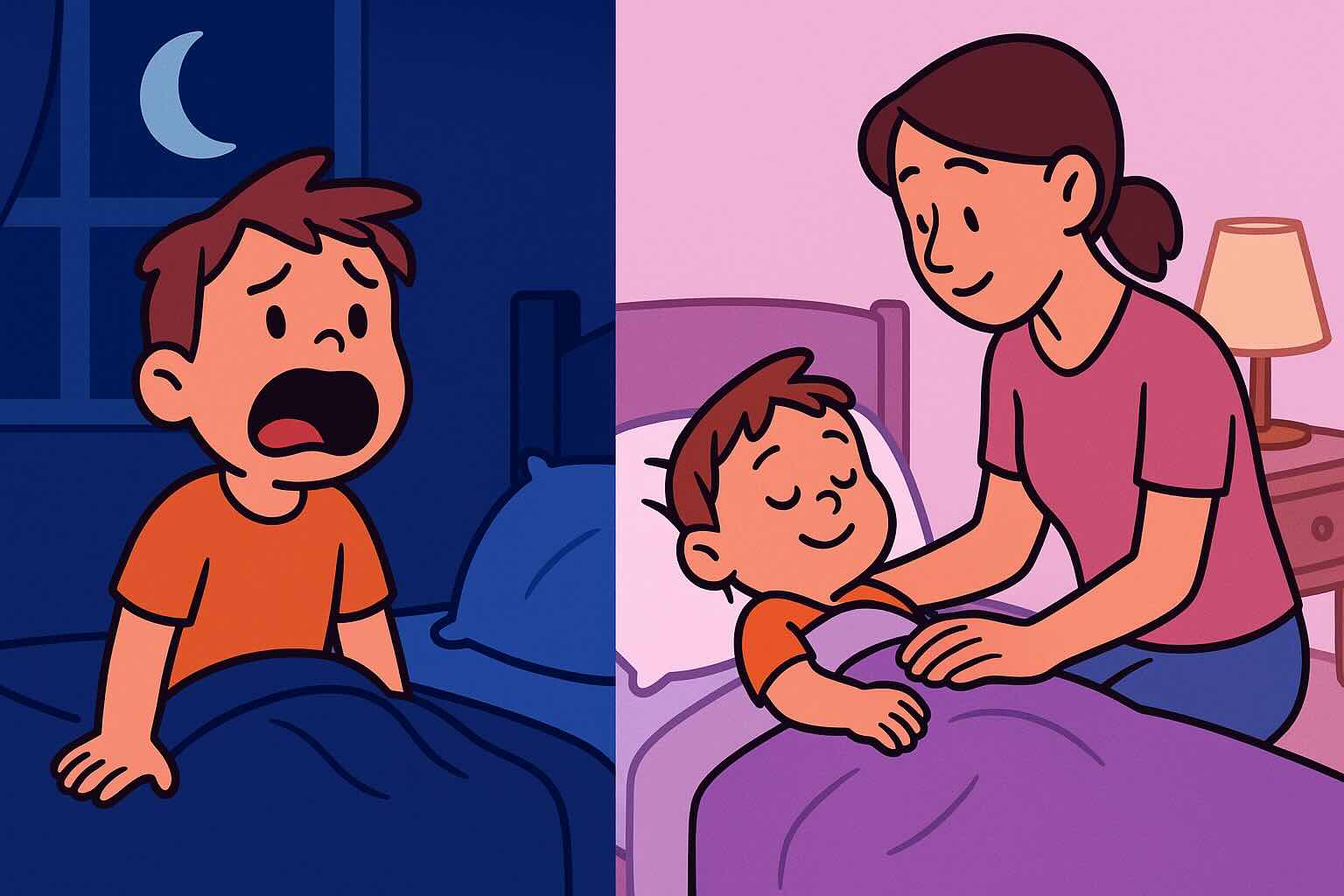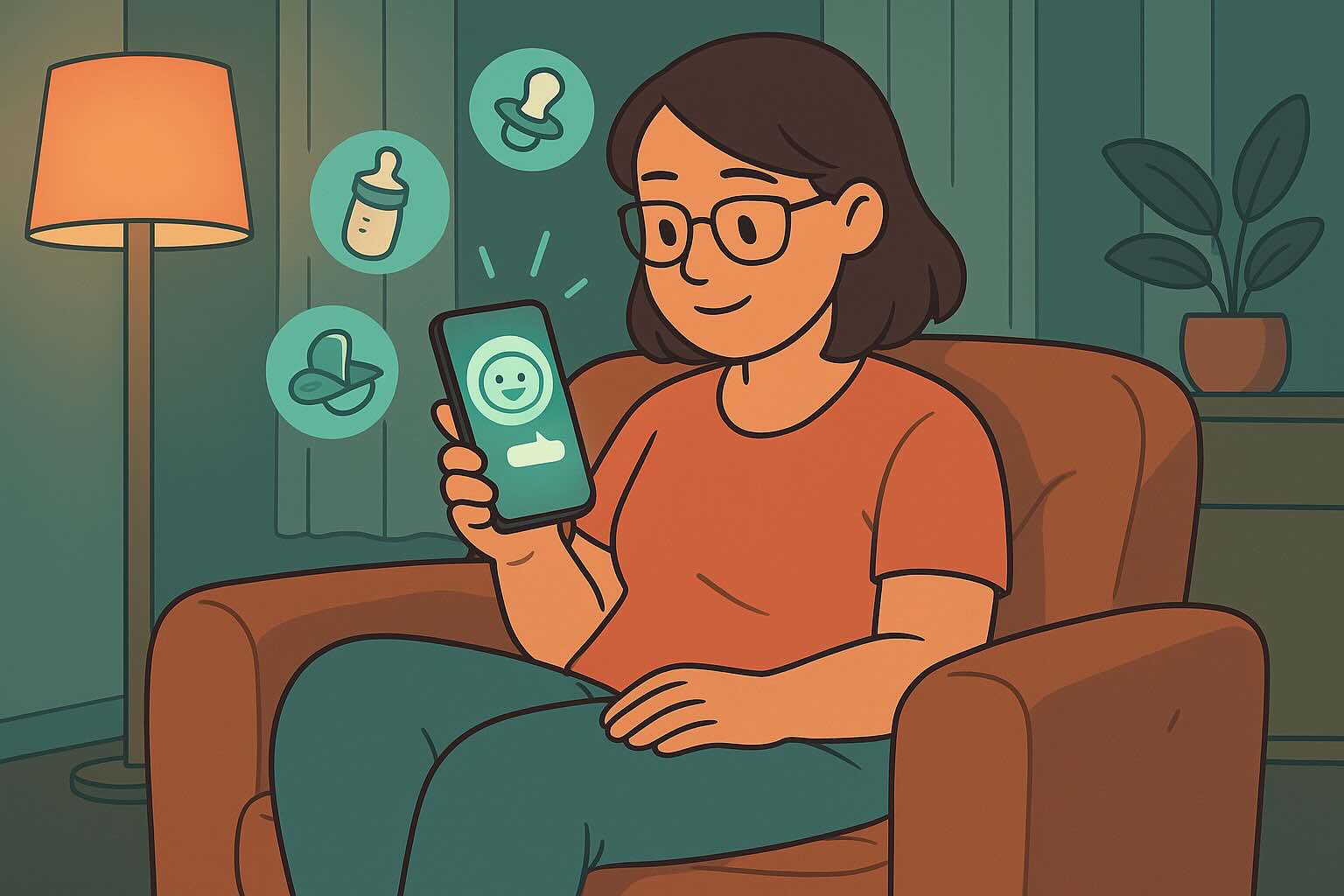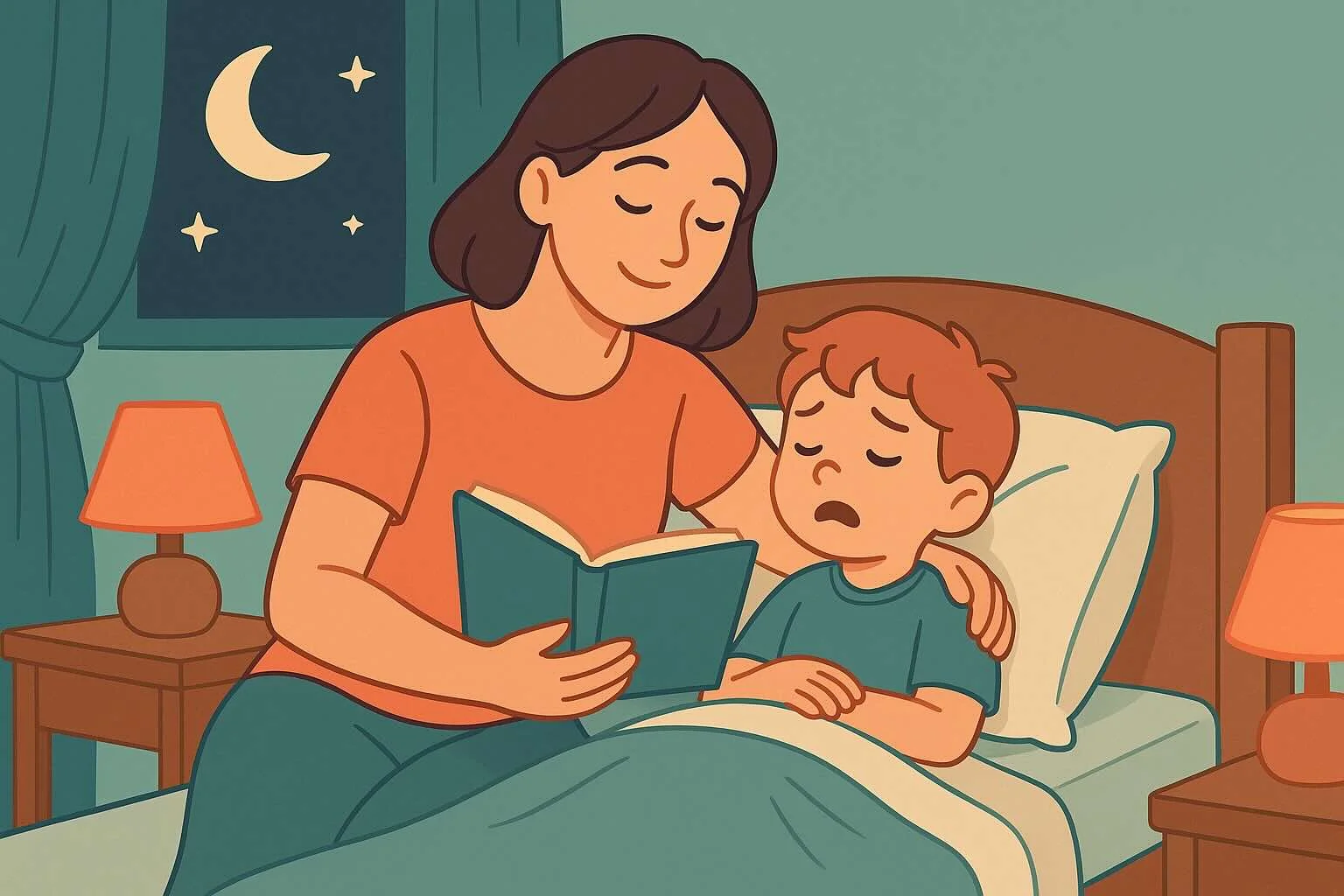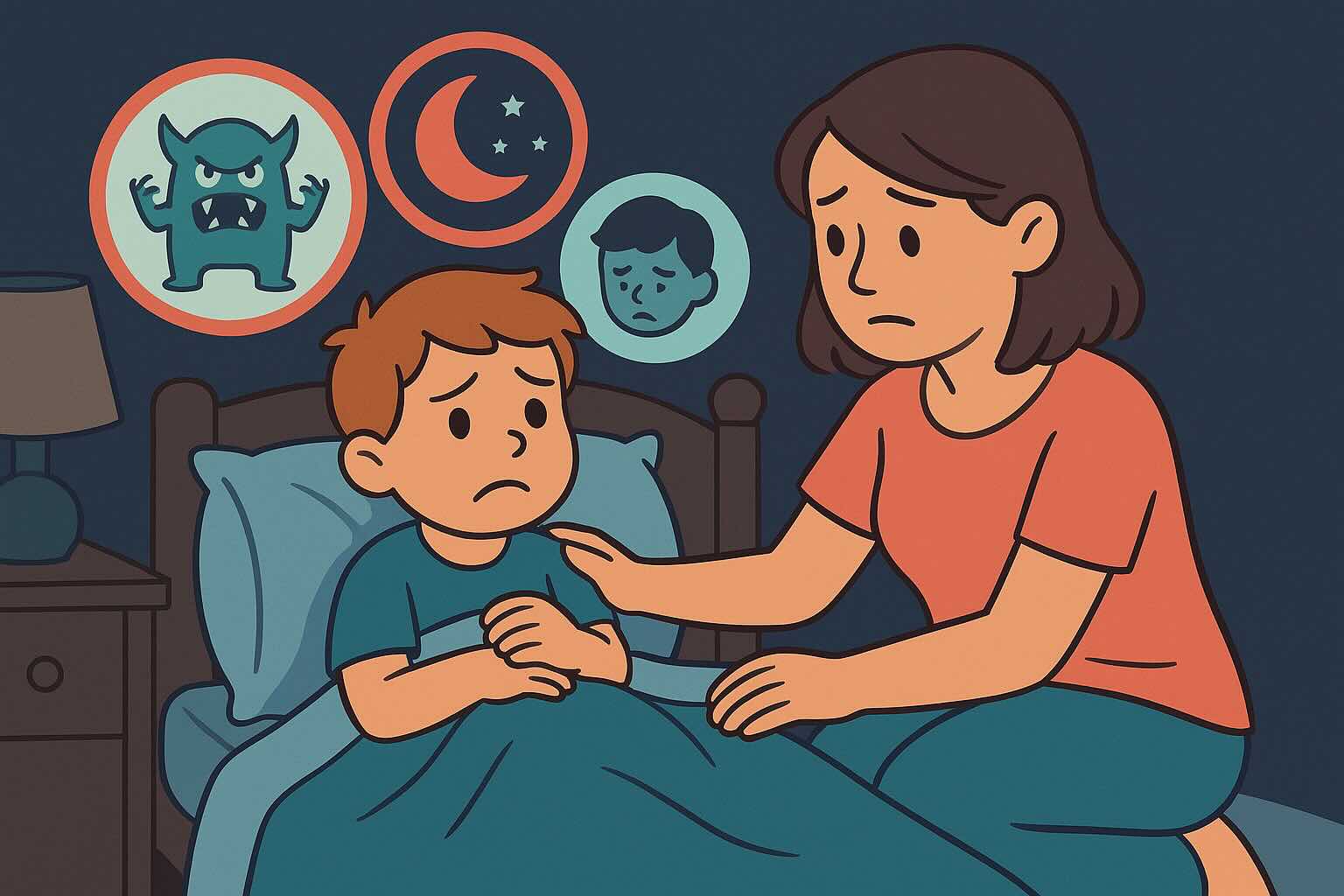Child Waking Up Screaming? Night Terrors vs Nightmares (Ages 3-7)


It's 2 AM and your child's blood-curdling scream jolts you from deep sleep. Heart racing, you stumble to their room to find them sitting up, eyes wide but unseeing, screaming as if terrified. You try to comfort them, but they push you away, still screaming. Or maybe they're crying, calling for you even though you're right there, trapped in some invisible nightmare you can't reach into.
If this scenario sounds terrifyingly familiar, you're not alone. Studies show that 40% of children experience frequent nightmares, while 5-15% suffer from night terrors. The exhaustion, worry, and helplessness you feel watching your child scream in the night is one of parenting's most distressing experiences. But understanding what's happening—and having the right response strategies—can transform these terrifying nights into manageable events.
Night Terrors vs. Nightmares: Critical Differences
Night Terrors: The Deep Sleep Phenomenon
Night terrors (also called sleep terrors) are not dreams at all—they're a partial awakening from deep sleep where your child is caught between sleep states:
Identifying Features:
- Occur in first 2-3 hours after bedtime
- Child appears awake but isn't responsive
- Eyes may be open but glassy/unfocused
- Intense fear, screaming, thrashing
- Sweating, rapid heartbeat, fast breathing
- Pushes away comfort attempts
- No memory of episode in morning
- Lasts 5-20 minutes typically
What's Happening in the Brain: During deep sleep, your child's brain attempts to transition to the next sleep cycle but gets "stuck." The fear centers activate while consciousness remains offline—like a smoke alarm going off while the security system is disabled.
Nightmares: The REM Sleep Dreams
Nightmares are actual bad dreams that occur during REM (rapid eye movement) sleep:
Identifying Features:
- Usually occur after 2 AM (during REM-heavy sleep)
- Child wakes fully and is aware
- Can describe the scary dream
- Seeks comfort and responds to it
- Remembers the event next day
- May resist going back to sleep
- Fear makes logical sense
- Can be talked through it
What's Happening in the Brain: During REM sleep, the emotional centers are highly active while logic centers are suppressed. This creates vivid, often illogical scary scenarios that feel completely real to your child.
Age-Specific Patterns and Causes
3-4 Year Olds: Peak Terror Time
This age experiences the highest rate of both night terrors and nightmares:
Common Triggers:
- Overtiredness (missed naps, late bedtime)
- Major developmental leaps
- Starting preschool stress
- Potty training pressure
- New sibling arrival
- Vivid imagination development
Typical Patterns:
- Night terrors 1-3 hours after sleep
- Nightmares about monsters, separation
- Confusion between reality and dreams
- May develop bedtime resistance
5-7 Year Olds: Processing Complex Fears
Older children's night disturbances often reflect daytime anxieties:
Common Triggers:
- School stress and social pressures
- Real-world fears (news, overheard conversations)
- Performance anxiety
- Friend conflicts
- Family changes
- Media exposure
Typical Patterns:
- More elaborate nightmares
- Night terrors during stress periods
- May fake nightmares for attention
- Can verbalize fears better
For managing bedtime anxiety that can trigger night problems, see our nighttime fears complete guide.
Immediate Response Strategies
For Night Terrors: The Gentle Guardian Approach
Do This:
- Stay Calm - Your panic won't help
- Ensure Safety - Remove dangerous objects
- Don't Restrain - Unless preventing injury
- Minimal Interaction - Don't try to wake
- Soft Presence - Stay nearby quietly
- Wait It Out - Usually ends in 5-15 minutes
- Return to Bed - Guide gently back to sleep
Don't Do This:
- Try to wake them forcefully
- Turn on bright lights
- Shake or yell
- Hold tightly (may increase agitation)
- Panic or show fear
- Discuss it immediately after
What to Say (Softly):
- "You're safe"
- "Mommy/Daddy is here"
- "Everything is okay"
- (Or say nothing—just be present)
For Nightmares: The Comfort Connection Response
Immediate Steps:
- Go Quickly - Fast response builds security
- Turn on Dim Light - Just enough to orient
- Physical Comfort - Hugs if wanted
- Validate Fear - "That sounds really scary"
- Reality Check - "It was a dream, you're safe now"
- Stay Until Calm - Don't rush away
- Rebuild Safety - Check room together if needed
Comfort Scripts:
- "You had a scary dream. Dreams aren't real."
- "I know it felt real, but you're safe in your room."
- "Let's think of something happy instead."
- "Would you like to tell me about it?"
- "I'll stay until you feel better."
Morning After:
- Discuss briefly if child brings it up
- Normalize: "Everyone has bad dreams sometimes"
- Problem-solve: "What might help next time?"
- Move on—don't dwell
Prevention Strategies That Actually Work
The Sleep Hygiene Foundation
Consistent Bedtime Routine:
- Same time every night (even weekends)
- 30-45 minute wind-down period
- Predictable sequence of events
- Calming activities only
- No screens 1 hour before bed
Optimal Sleep Environment:
- Cool room (68-72°F)
- Dark but not pitch black
- White noise or soft music
- Comfortable mattress/pillows
- Security object available
Age-Appropriate Sleep Needs:
- 3-4 years: 10-13 hours total
- 5-7 years: 9-12 hours total
- Consistent wake time crucial
- Naps only if not affecting night sleep
The Scheduled Awakening Technique (For Night Terrors)
If night terrors occur predictably:
- Track Timing - Note when terror typically occurs
- Wake 15 Minutes Before - Gently rouse child
- Brief Awakening - Just enough to mumble/move
- Let Return to Sleep - Don't fully wake
- Repeat 7-10 Nights - Breaks the pattern
- Gradually Stop - Reduce awakenings slowly
Success rate: 80% reduction in night terrors
Stress Reduction Strategies
Daily Stress Management:
- Regular physical activity (not near bedtime)
- Outdoor time for natural light
- Predictable daily routine
- Limited overscheduling
- One-on-one connection time
Bedtime Anxiety Busters:
- "Worry time" earlier in day
- Gratitude practice at bedtime
- Progressive muscle relaxation
- Guided imagery to happy place
- Monster spray or dream catchers
Processing Fears:
- Draw the scary dream (then transform it)
- Create new dream endings
- Build "brave thoughts" list
- Practice coping statements
- Role-play being brave
Creating a Prevention Plan
The Four-Week Sleep Transformation
Week 1: Establish Foundation
- Set consistent bedtime/wake time
- Create calming bedtime routine
- Remove bedroom screens
- Track any episodes
Week 2: Address Triggers
- Ensure adequate total sleep
- Reduce evening stimulation
- Address any stressors
- Add relaxation techniques
Week 3: Build Security
- Strengthen bedtime routine
- Add comfort objects
- Practice brave thoughts
- Implement scheduled awakening if needed
Week 4: Maintain and Adjust
- Continue successful strategies
- Adjust based on progress
- Celebrate improvements
- Plan for setbacks
Most families see 50-70% improvement within one month.
When Night Screaming Needs Medical Attention
Red Flags for Pediatric Consultation
Frequency/Severity Concerns:
- Nightly episodes for over 2 weeks
- Multiple episodes per night
- Episodes lasting over 30 minutes
- Injury during episodes
Associated Symptoms:
- Snoring or breathing pauses
- Daytime sleepiness despite adequate sleep
- Behavioral regression
- New onset after age 7
- Seizure-like movements
Physical Symptoms:
- Complaints of pain
- Fever with night episodes
- Bedwetting after dry period
- Weight loss or poor growth
Psychological Impact:
- Severe bedtime anxiety
- School refusal
- Daytime anxiety/depression
- Family functioning disrupted
Medical Conditions to Rule Out
- Sleep Apnea - Snoring, gasping, restless sleep
- Reflux - Crying/screaming shortly after lying down
- Seizures - Rhythmic movements, unresponsive
- Allergies/Sinus Issues - Congestion affecting sleep
- Growing Pains - Leg pain causing wakings
Building Long-Term Sleep Resilience
The Sleep Success System
Daily Practices:
- Morning sunlight exposure
- Physical activity (not late)
- Consistent meal times
- Limited caffeine/sugar
- Emotional check-ins
Weekly Practices:
- Review sleep patterns
- Adjust bedtime if needed
- Plan for upcoming stressors
- Celebrate good nights
- Problem-solve challenges
Monthly Practices:
- Evaluate overall progress
- Adjust strategies as needed
- Check in with pediatrician if concerned
- Update comfort tools
- Maintain consistency
For comprehensive sleep strategies, explore our healthy sleep habits guide.
Real Success Stories
Sarah's Scheduled Success
"My 4-year-old had night terrors every night at 11 PM. We started waking him at 10:45, just enough to mumble. After a week, no more terrors! It felt like magic. We gradually stopped the wakings after two weeks, and they haven't returned."
Marcus's Monster Solution
"My daughter's nightmare screams were nightly. We created 'dream dust' (glitter in a jar) that turns bad dreams good. She sprinkles it on her pillow. Placebo? Maybe. But screaming reduced 90% immediately."
Priya's Prevention Plan
"Realized my son's night terrors correlated with missed naps. Reinstated quiet time (not necessarily sleep) from 1-2 PM. Night terrors stopped completely within three days."
Your Action Plan for Tonight
Immediate Steps (Today):
- Determine pattern: terror or nightmare?
- Set earlier bedtime (prevent overtiredness)
- Create calming routine starting now
- Remove bedroom screens
This Week:
- Track episodes with time/duration
- Identify potential triggers
- Implement one prevention strategy
- Practice calm response
This Month:
- Establish consistent sleep schedule
- Address underlying stressors
- Build security routines
- Celebrate progress (any improvement counts!)
The Hope You Need Today
Night screaming is temporary. Whether night terrors or nightmares, most children outgrow these sleep disturbances by school age. The terrifying nights you're experiencing now will become distant memories.
Every calm response you provide builds your child's sense of security. Every consistent bedtime routine strengthens their sleep system. Every strategy you implement moves you closer to peaceful nights.
Your Next Steps
You don't have to endure sleepless, frightening nights indefinitely. Start with one strategy from this guide—whichever feels most manageable tonight.
For specific age-appropriate bedtime routines, explore our bedtime battles guide for detailed evening strategies.
If night screaming is accompanied by bedtime anxiety, our bedtime fears guide provides comprehensive fear-management techniques.
Remember: Your child isn't choosing to wake screaming, and you're not failing as a parent. With understanding, consistency, and the right strategies, peaceful nights are ahead. You've got this, and we're here to support you through every scream-filled night until they stop.
24/7 AI Parenting Assistant
Get instant, personalized advice with expert-curated parenting knowledge. Chat with your AI coach anytime, anywhere.

Expert Content Library
Access multimedia resources, articles, and expert-reviewed content organized by topics and your child's age.

Get Your Free Sleep Training Toolkit
5-day email course + printable sleep log to help your baby sleep through the night
Frequently Asked Questions
Need personalized support?
RootWise's AI coach can provide tailored strategies for your specific situation, available 24/7 when you need it most.
Learn More About AI Coaching →



